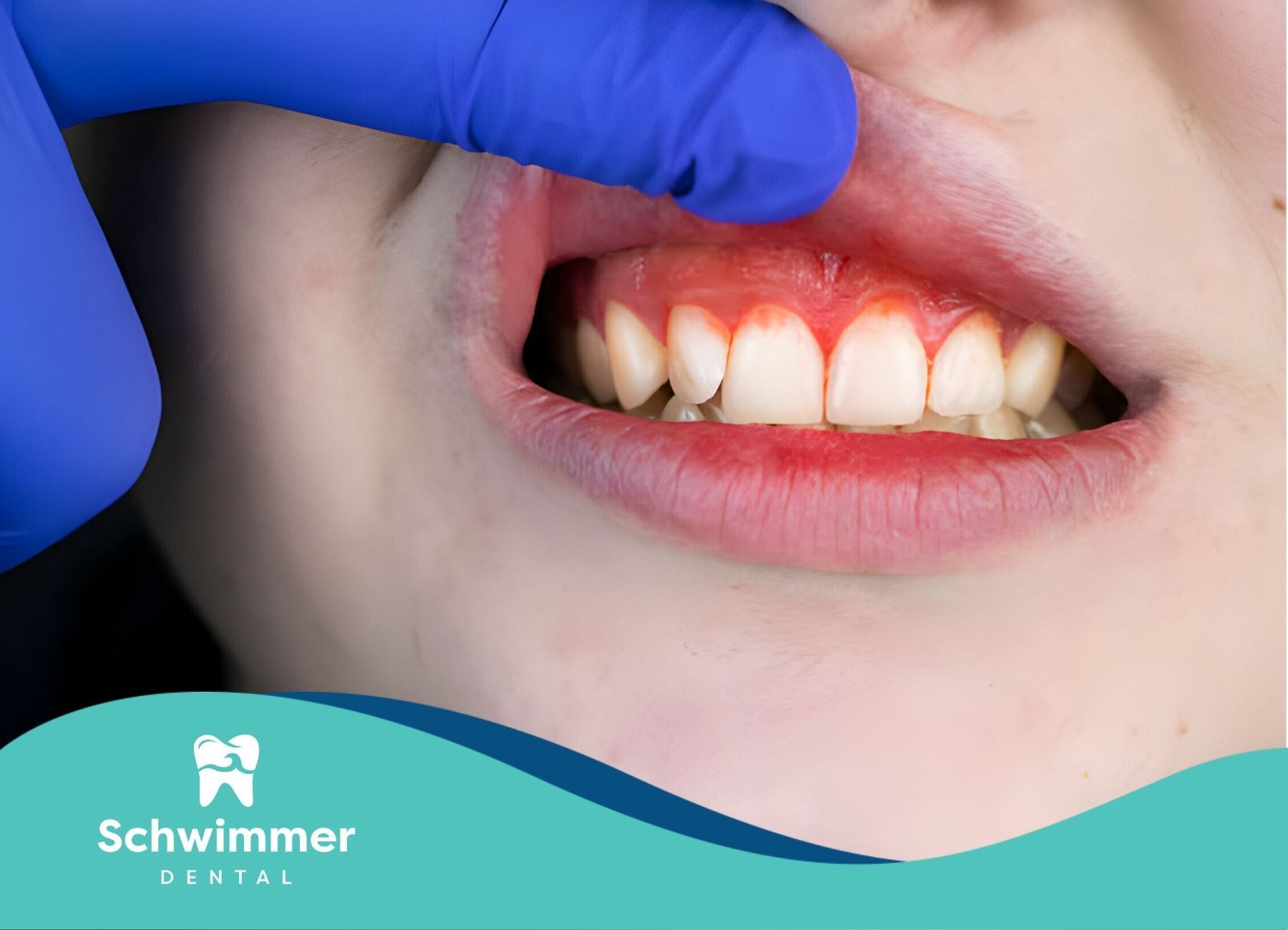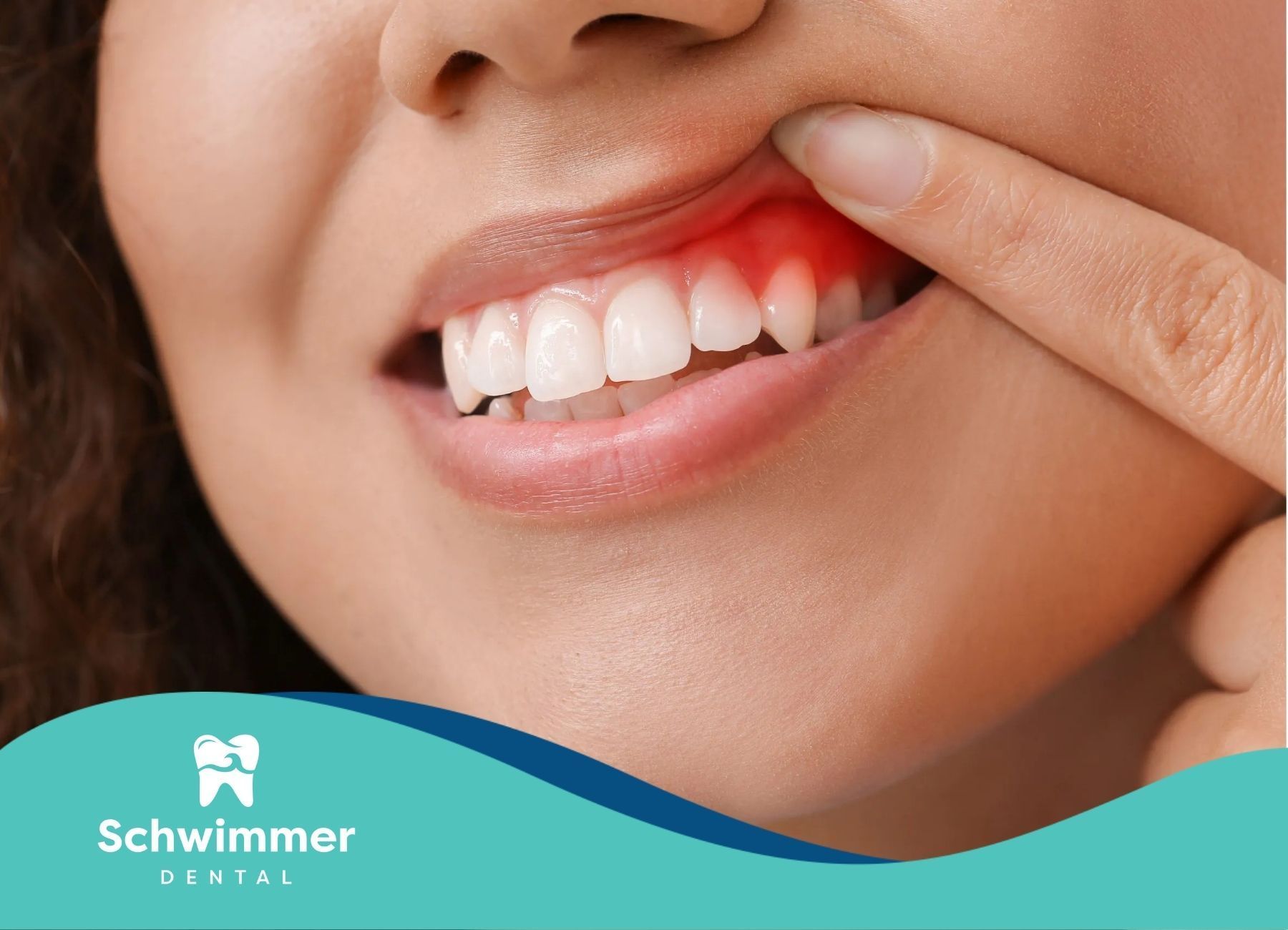Have an appointment? Complete the Intake Form
Understanding Periodontal Disease: Causes & Treatment Options
Periodontal disease, often referred to as gum disease, poses a significant threat to oral health, impacting millions globally. This inflammatory condition affects the tissues that surround and support our teeth. Understanding the most common symptoms of gum disease is paramount. Recognizing early indicators like redness, swelling, or bleeding in the gums, persistent bad breath, and even loose teeth can make a significant difference. Early detection paves the way for timely intervention and improved treatment outcomes.
The Basics of Periodontal Disease
Periodontal disease at its core signifies an infection that attacks the gum tissue and bone anchoring our teeth. This infection arises from the accumulation of bacteria-laden plaque along and below the gum line. When left unaddressed, this plaque hardens into tartar, further exacerbating the issue.
The stage of gum disease dictates its severity. Gingivitis, the mildest form of untreated gingivitis and periodontal disease, primarily involves gum inflammation. However, if neglected, it can advance to periodontitis. As periodontitis progresses, it gradually erodes the supporting bone and tissues, ultimately jeopardizing the stability of teeth and even leading to tooth loss.
Defining Periodontal Disease: More Than Just Gum Disease
While frequently termed "gum disease," periodontal disease encompasses much more than gum issues. It's a serious infection capable of inflicting irreversible damage upon the bones and infection of the tissues that underpin our teeth. Understanding this distinction is crucial for grasping the potential consequences of neglecting oral health.
The crux of the matter lies in the progression of periodontal disease. It usually begins subtly with gingivitis, marked by gum inflammation, redness, and occasional bleeding. However, without proper care, it can escalate to periodontitis, the advanced stage of gum disease.
During periodontitis, the infection penetrates deeper, impacting the periodontal ligament and alveolar bone – vital components responsible for anchoring teeth. Consequently, this destructive process leads to bone loss, ultimately causing teeth to loosen and potentially resulting in tooth loss.
The Importance of Recognizing Early Symptoms
Given its potential to escalate silently, recognizing the warning signs of periodontal disease, even in its early stages, is crucial for safeguarding oral health. While bleeding gums during brushing or flossing serve as a primary indicator, other subtle signs often go unnoticed.
Persistent bad breath, a common side effect of bacterial accumulation in the oral cavity, can also signify underlying periodontal issues. Moreover, pay close attention to changes in your bite, receding gums, pus formation around the gums, and sensitivity or pain while chewing.
Detecting these signs early and seeking prompt dental care significantly impact treatment success, potentially preventing complications like bone loss and tooth loss. Ignoring these symptoms allows the disease to advance, leading to more complex and invasive treatment approaches later on.
Understanding the causes of periodontal disease is crucial for maintaining optimal oral health. Regular dental checkups and professional cleanings are essential. To find the best dentists near you, consider scheduling a consultation and discussing your concerns with a qualified dental professional.
Unveiling the Causes Behind Periodontal Disease
The primary culprit behind periodontal disease is the buildup of bacterial plaque on teeth and gums. However, various factors can either increase the risk of developing this condition or exacerbate its progression. While poor oral hygiene practices undoubtedly play a significant role, other contributing elements warrant attention.
Certain health conditions like diabetes can make individuals more susceptible to infections, including periodontal disease. Furthermore, lifestyle choices like smoking can hinder the body's ability to repair gum tissue, making smokers particularly vulnerable, as highlighted in J Clin Periodontol. Recognizing and addressing these factors through lifestyle changes, proper disease management, and meticulous oral hygiene is crucial in preventing and managing periodontal disease effectively.
How Lifestyle and Health Conditions Influence Risk
Maintaining good oral hygiene is fundamental to preventing periodontal disease. However, certain lifestyle choices and health conditions can significantly increase an individual's susceptibility to this oral ailment, as highlighted by the American Dental Association. Recognizing these risk factors is crucial for promoting early detection and proactive management.
Smoking stands out as a prominent risk factor. It not only weakens the body's natural defense mechanisms but also compromises blood flow to the gums, hindering the healing process and accelerating gum tissue destruction.
Moreover, systemic diseases like diabetes and rheumatoid arthritis can negatively impact oral health. Individuals with diabetes often experience compromised healing capabilities, rendering them more vulnerable to infections like periodontal disease, which can enter the bloodstream. Similarly, rheumatoid arthritis, an autoimmune disorder, can trigger inflammation in various body parts, including the gums, escalating the risk of periodontal problems.
The Role of Plaque and Bacteria in Gum Degradation
The crux of periodontal disease lies in the relentless activity of dental plaque, a sticky film brimming with bacteria. This bacterial haven forms on teeth, particularly along the gum line, due to consuming sugary foods and beverages. When neglected, it sets the stage for gum deterioration and, eventually, bone loss.
These bacteria release toxins that irritate the gums, triggering an inflammatory response in the body. Consequently, the gums become inflamed, red, and more prone to bleeding, a condition known as gingivitis - the initial stage of gum disease.
Without proper intervention, the inflammation extends beyond the gums, causing the formation of pockets between the teeth and gums. These pockets become breeding grounds for bacteria, further fueling the inflammatory process and ultimately destroying the supporting bone and tissues that hold teeth in place, resulting in various health problems.
Comprehensive Diagnosis Techniques
Timely diagnosis is crucial in managing periodontal disease effectively. While maintaining good oral hygiene helps prevent its onset, seeking professional treatment of gum disease becomes essential upon noticing any early signs such as bleeding gums or persistent bad breath. Dental professionals utilize various techniques to diagnose and evaluate the severity of periodontal disease.
The process begins with a visual examination of the gums and teeth, checking for inflammation, recession, and plaque buildup. A periodontal probe measures pocket depths around each tooth, providing insights into potential bone loss. Depending on the complexity of the case, advanced diagnostic tools may be employed for a comprehensive assessment.
Professional Evaluation: What to Expect During Your Visit
Upon visiting a dental professional, such as a gum specialist, for suspected periodontal disease, they will conduct a thorough evaluation to diagnose the condition's presence and severity. The American Academy of Periodontology emphasizes the importance of a comprehensive assessment, which typically involves the following steps:
The dental hygienist or dentist will begin by inquiring about your medical and dental history, including any existing conditions or medications. This information helps determine potential risk factors. Next, a visual examination of your gums and teeth will be carried out, looking for signs of inflammation, recession, and plaque accumulation. They might use a tiny ruler, called a periodontal probe, to measure the spaces between your teeth and your gum line (periodontal pockets.) In a healthy mouth, the pockets are usually 1 to 3 millimeters deep. Pockets that are 4 millimeters or deeper indicate gum disease.
Your dentist may also order dental X-rays to visualize the bone levels supporting your teeth, identifying any bone loss that may have occurred due to periodontal disease.
| Examination Aspect | Purpose |
|---|---|
| Medical and Dental History Review | Identify potential risk factors and underlying health conditions |
| Visual Examination | Assess gum inflammation, recession, and plaque buildup |
| Periodontal Probing | Measure pocket depths to evaluate bone loss |
| Dental X-rays | Visualize bone levels and confirm bone loss extent |
Advanced Diagnostic Tools and Their Impact on Treatment Planning
In certain cases, dentists utilize advanced diagnostic tools for deeper insights into periodontal disease progression and to tailor personalized treatment strategies. Imaging techniques, such as digital radiography and cone beam computed tomography (CBCT), provide detailed views of the jawbone, revealing the extent of bone loss with greater precision.
Furthermore, in situations where a definitive diagnosis is required, a biopsy of the gum tissue may be recommended. This procedure allows for microscopic examination of the tissue to rule out any other underlying conditions and confirm the presence of periodontal disease.
The data gathered from these advanced tools guides the dentist in formulating a tailored treatment plan, which may involve non-surgical therapies like scaling and root planing, PRP therapy, or surgical interventions such as flap surgery or guided tissue regeneration, depending on the severity.
Effective Treatment Strategies
The treatment options for periodontal disease depend on the stage and severity of the condition. Dentists usually recommend beginning with the most conservative approaches, such as nonsurgical treatments and may refer patients to a periodontist for more advanced cases, reserving surgical procedures for those situations.
Nonsurgical treatments primarily aim to control the infection and prevent further damage. These include professional dental cleaning (scaling and root planing), antimicrobial therapy, and oral hygiene instructions to improve at-home care. If these measures prove insufficient in halting disease progression, surgical intervention might become necessary to restore damaged tissues and prevent tooth loss.
Non-Surgical Treatments to Manage Periodontal Disease
In the battle against periodontal disease, non-surgical treatments serve as the first line of defense. These procedures are primarily designed to control bacterial infection and prevent further damage to the gums and supporting bone. Addressing the root cause of the inflammation is paramount.
A common non-surgical procedure is scaling and root planing, a deep cleaning procedure that reaches below the gum line to eliminate plaque and tartar buildup. Depending on the severity, the dentist might recommend antimicrobial therapy, either topical or oral, to further suppress bacterial growth and promote healing using plasma techniques.
Alongside professional intervention, maintaining good oral hygiene at home is crucial. This involves:
- Brushing twice daily using a soft-bristled toothbrush and fluoride toothpaste.
- Daily flossing to remove plaque and debris from between teeth.
- Rinsing with an antiseptic mouthwash as advised by the dentist.
- Regular dental checkups and cleanings to monitor oral health and catch any signs of recurrence early.
When Surgery Becomes Necessary: Procedures Explained
When periodontal disease advances beyond the reach of non-surgical treatments, surgical procedures become necessary. Such interventions aim to repair the damage inflicted by the disease and prevent further tooth loss.
Flap surgery is a common periodontal procedure used to reduce pocket depth and facilitate a more thorough cleaning. In this procedure, the gums are lifted back to access the root surfaces and remove infected tissues and tartar deposits. In situations where bone loss has occurred, bone grafting may be recommended.
This procedure involves placing bone graft material into areas where bone has been lost, stimulating new bone growth and providing better support for the teeth. In some cases, tissue regeneration procedures, like guided tissue regeneration, may be used in conjunction with bone grafting to promote the growth of new gum tissue and enhance the overall outcomes of the surgery.
Conclusion
In conclusion, understanding periodontal disease is crucial for early detection and effective treatment. Lifestyle choices and oral hygiene, along with regular care, play significant roles in preventing its progression. By recognizing symptoms early and seeking professional evaluation, you can address the issue promptly. Non-surgical treatments and, if necessary, surgical procedures are available to manage periodontal disease effectively. Remember, periodic dental check-ups are essential for maintaining oral health. If you have concerns about your gum health, don't hesitate to consult a dental professional for personalized care and guidance. Your oral health matters, so take proactive steps to protect it.
At Schwimmer Dental, we understand that understanding the causes of periodontal disease is crucial for maintaining optimal oral health. Our experienced team in New Jersey provides comprehensive dental care, including thorough examinations and personalized treatment plans to address periodontal issues. Schedule a consultation today to learn more about preventing and treating periodontal disease and achieve a healthy, beautiful smile.
Frequently Asked Questions
Can Periodontal Disease Recur After Treatment?
Yes, even after successful treatment, periodontal disease can recur. Recurrence depends on various factors, including the effectiveness of ongoing maintenance, follow-up care, individual immune system responses, and lifestyle factors such as smoking.
Need Assistance? We’re Here to Help
We are dedicated to enhancing your dental health and well-being.
We provide personalized dental care solutions for a confident, healthy smile.
Contact us today for Professional Dental Care.

Our caring staff will help you feel relaxed and comfortable in our state of the art office. We respect your time and pledge to deliver prompt service, backed by the latest knowledge, techniques, and technology.
Email: Office@schwimmerdental.com
Tel: (848) 294-2385
Fax: (732) 899-3347
Address: 1115 Arnold Ave,
Point Pleasant, NJ, 08742
Schwimmer Dental – Website by CWS


